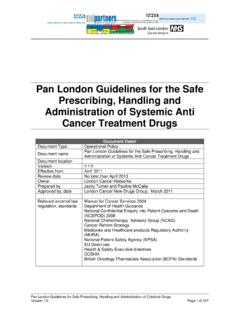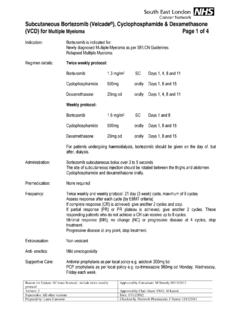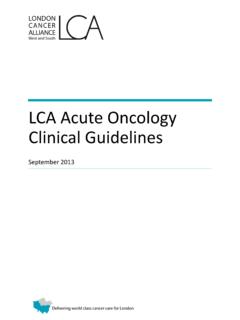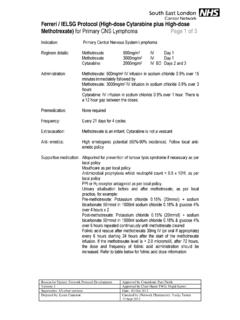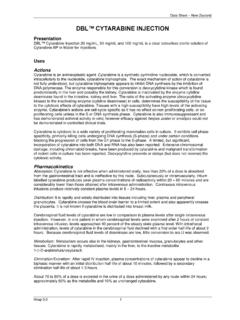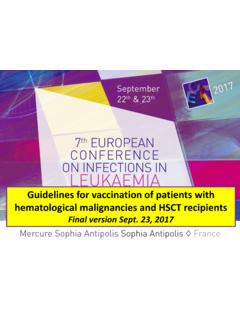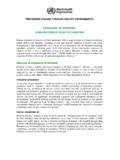Transcription of LCA Haemato-Oncology Clinical Guidelines
1 LCA Haemato-Oncology Clinical Guidelines Acute leukaemias and Myeloid Neoplasms Part 2: Acute Myeloid Leukaemia April 2015 LCA Haemato-Oncology Clinical Guidelines 2 Contents 1 Introduction .. 5 2 Referral Pathways .. 6 3 Investigation and Diagnosis .. 8 Fertility .. 9 Pathology .. 9 Imaging .. 9 Core diagnostic criteria .. 9 AML classification .. 13 4 Risk Stratification at Diagnosis .. 15 Cytogenetic abnormalities in AML .. 15 Molecular stratification .. 16 Other prognostic factors .. 18 Acute promyelocytic leukaemia (APML) .. 18 5 Response Criteria .. 20 6 Patient Information and Support .. 21 7 Treatment .. 22 Initial management considerations .. 22 Age- and risk-specific therapeutic approach .. 23 APML treatment .. 27 8 Management of Disease and Treatment-related Complications .. 31 Anaemia .. 31 Severe neutropenia .. 31 Neutropenic sepsis .. 31 Severe thrombocytopenia.
2 31 Thrombosis/haemostasis .. 32 Hyperleukocytosis/hyperviscosity syndrome .. 32 Hyperviscosity syndrome .. 33 Leukapheresis .. 33 Tumour lysis syndrome (TLS).. 33 Hyperuricaemia .. 33 CONTENTS 3 Myeloid sarcomas .. 33 CNS disease .. 33 Pregnancy and AML (adapted from ELN/BCSH Guidelines ) .. 34 Initial cytoreduction with hydroxyurea .. 34 Ara-C-induced conjunctivitis .. 34 Ara-C (CYSTAR) syndrome .. 35 ATRA (tretinoin) syndrome .. 35 Anthracycline-related myocardial damage .. 35 9 Supportive Care .. 37 Transfusions .. 37 Haemostasis and thrombosis .. 37 Hyperviscosity syndrome .. 37 Hyperuricaemia .. 37 Tumour lysis syndrome .. 37 Infection prophylaxis .. 38 Mouth care .. 38 Control of menstruation .. 38 Breathlessness .. 38 Weight loss .. 39 Pain .. 39 Complex symptom management .. 39 10 Rehabilitation and Survivorship .. 40 11 End-of-treatment Information.
3 41 End of treatment .. 41 Treatment summary and care plan .. 41 12 Follow-up Arrangements .. 42 13 Research/ Clinical Trials .. 43 14 End-of-life Care .. 44 15 Data Requirements .. 44 LCA Haemato-Oncology Clinical Guidelines 4 References .. 45 Annex 1: LCA Acute Myeloid Leukaemia Checklist .. 48 Annex 2: Acute Leukaemia Patient Pathway .. 49 Annex 3: LCA Acute leukaemias and Myeloid Neoplasms BMAT Diagnostics Summary Chart .. 50 Annex 4: Multidisciplinary Teams (MDTs) and Constituent Hospital Trusts .. 51 Annex 5: Guideline for the Management of Tumour Lysis Syndrome (TLS) .. 52 Annex 6: Guidelines for Use of Rasburicase in Adult Haematology and oncology Patients .. 54 Annex 7: Oral Chemotherapy Patient Education Checklist .. 56 Annex 8: Monitoring of Long-term Survivors of Chemotherapy .. 58 Annex 9: NLBSS High-risk Referral Form for Haemato-Oncology Patients .. 60 Annex 10: SIHMDS or Current Diagnostic Services and Contacts.
4 61 Annex 11: JACIE-accredited Transplant Centres in the LCA .. 62 Annex 12: Data Requirements .. 62 Appendices .. 65 INTRODUCTION 5 1 Introduction Acute myeloid leukaemia (AML) is an uncommon and heterogeneous clonal haematopoietic neoplasm. It represents around 40% of all leukaemias in adults; the incidence rises sharply in adults over the age of 50. It is a particularly aggressive cancer that can only be cured in approximately 30 45% of patients who are fit enough to withstand intensive chemotherapy. For those who are cured, there is a lifetime of increased risks of secondary cancers, cardiovascular disease and diabetes due to the adverse effects of treatment. The heterogeneity of AML extends not only to the disease phenotype, but also to the many molecular aberrations that are associated with leukaemogenesis, making the diagnostic and treatment monitoring pathway particularly specialised and targeted to the AML sub-type.
5 Patients diagnosed with AML should be cared for by Haemato-Oncology subspecialists in a BCSH (British Committee for Standards in Haematology) at least Level 2 Haemato-Oncology Unit (2a or 2b, dependent on intensity of chemotherapy to be given) which participates in Clinical trials for patients with AML. These Guidelines have been derived in part from the European Leukaemia Net Consensus Guidelines on the diagnosis and management of AML, the original BCSH AML Guidelines , and incorporating further details on Clinical trials and diagnostic/treatment options relevant to the , 2 The guideline is not designed to be exhaustive, but should act as a guide. All new cases of AML should be discussed at the multidisciplinary team (MDT) meeting to agree the treatment pathway (see Annex 4). Treatment for AML is quite regimented and driven by well-defined protocols within the trial set-up. This guideline will not recapitulate these Clinical trials, but is a general guide to treatment strategies for new and relapsed patients.
6 The main considerations are: AML may be a curable disease in young and older fit patients. It becomes harder to treat with age; fewer patients are cured as age advances and therapeutic complications are increasingly common. All patients should be treated with therapy targeted to the performance status and AML risk stratification. Since the disease is rare and treatment is complicated, there are many areas of controversy where best practice is not defined. Patients should be treated within a Clinical trial wherever possible. Experienced specific and supportive care is required in a BCSH at least Level 2 unit which offers Clinical trials. LCA Haemato-Oncology Clinical Guidelines 6 2 Referral Pathways See Annex 2. Patients with suspected AML should be referred to a haematologist for assessment on the same day on a 2 week wait pathway (See Appendix 1: 2 Week Wait Referral Forms).
7 Patients with severe neutropenia, thrombocytopenia or blasts in peripheral blood picked up on a routine blood test via the laboratory and suspected AML should be urgently referred to an A&E department or directly to a haematology inpatient unit which treats AML (BCSH Level 2 3), following discussion with a haematologist. All new patients should be referred to the MDT for confirmation of diagnosis, prognosis and management plan, taking into account their performance status, needs and co-morbidities (see Annex 4). The following patients should be brought to the MDT: All new patients with AML in order to confirm the diagnosis and treatment plan. All patients where a new line of therapy needs to be considered. All patients with a re-staging assessment of response to treatment. All patients in whom an allogeneic stem cell transplant is a consideration. Information to be captured and documented prior to, or during, the MDT should include.
8 Demographic information Referring physician and/or GP Performance status An indicator of co-morbidities ( co-morbidity score) Any relevant history Pertinent positive and negative findings on physical examination (splenomegaly, rashes, lesions, CNS exam, etc) FBC, haematinics, LFTs, U&Es, LDH, urate, peripheral blast percentage Bone marrow aspirate and trephine (BMAT) histology Bone marrow aspirate immunophenotyping (critical for MRD assessment) Cytogenetic and molecular mutational status (critical for MRD assessment) Specific diagnostic AML sub-type by WHO 2008 Relevant imaging if applicable Risk stratification Availability of a Clinical trial/research study and if the patient is eligible Management and treatment plan Key worker/ Clinical nurse specialist REFERRAL PATHWAYS 7 Named consultant or team (dependent on local work pattern) For follow-up: bone marrow aspirate +/- trephine (trephine required post-cycle 1 at least) with MRD assessment, performance status/co-morbidities.
9 The MDT outcome form should be sent to the GP (email, or preferably fax) within 24 working hours of MDT discussion. Patients with AML should be discussed within two weeks of diagnosis. It is expected that treatment would have commenced prior to the MDT discussion. New patients should be discussed with the MDT AML lead or the MDT lead at presentation for urgent agreement on management plan prior to formal MDT discussion. Those who are newly diagnosed should have access to specialist Haemato-Oncology rehabilitation teams, physiotherapist, occupational therapist, speech and language therapist and dietitian. Where there are not currently specialist Haemato-Oncology teams, they should be able to access oncology specialists or, at a minimum, rehabilitation teams with access to support and advice from Haemato-Oncology specialists. Planning for an allogeneic stem cell transplant should begin at the time of diagnosis in conjunction with the transplant centre.
10 A joint approach with elderly care physicians and palliative care teams may be appropriate in patients with poor prognosis disease, poor performance status and who are not eligible for transplant. Patients who fail to respond to first-line therapy, lose response or experience disease progression may be discussed with a sub-specialist centre offering a Clinical trial for relapsed patients (see section 13: Research/ Clinical Trials), especially if they progress through second-line treatment. Patients considered for haematopoietic stem cell transplantation need to be referred early in their treatment (as soon as is practical and at the latest after recovery from cycle 1 induction) to a JACIE-accredited centre. LCA Haemato-Oncology Clinical Guidelines 8 3 Investigation and Diagnosis Patients may present with infection, bleeding, symptoms of anaemia or hyperviscosity, B-symptoms, bone pain, central nervous system (CNS) symptoms and/or cytopenias with or without hepatosplenomegaly.



